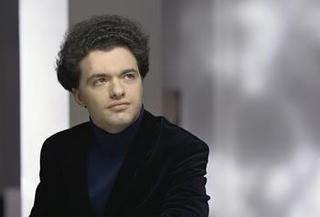|
Back
With Honor to the Composer New York
Isaac Stern Auditorium, Carnegie Hall
05/16/2015 -
Ludwig van Beethoven: Piano Sonata No. 21 in C Major,"Waldstein", Opus 53
Sergei Prokofiev: Piano Sonata No. 4 in C Minor
Frédéric Chopin: Nocturnes in B-flat Minor, Op. 9, No. 1, in B Major, Op. 9, No. 3, & in C Minor, Op. 48, No. 1 – Mazurkas in F-sharp Minor, Op. 6, No. 1, in C-sharp Minor, Op. 6, No. 2; in E Major, Op. 6, No. 3, in A Minor, Op. 7, No. 2, in F Minor, Op. 7, No. 3, & in C-sharp Minor, Op. 41, No. 1
Franz Liszt: Hungarian Rhapsody No. 15 in A Minor, "Rákóczi-Marsch”
Evgny Kissin (Pianist)

E. Kissin (© Sheila Rock)
The still-youthful Evgeny Kissin seems to have been with us forever. But at the ripe old age of 43, the Russian-born British/Israeli citizen has the same kind of pure musicality that he had at the beginning of his career. Neither showy nor diffident, neither over-fastidious or over-flashy, with programs that reflect his honesty and appreciation for the great piano music, Mr. Kissin made his May debut here last night, with a few more concerts to go.
Not only was this concert sold out with great parties of Russians celebrating their artist, but an overflow was seated on stage, to get a closeup look at the pianist. And gallantly, he bowed and saluted to each side of his Steinway. (Though, truth to tell, the sneezes, coughs and rustling in the audience would be enough to have any artist walk off in disgust.)
Still, ignoring the diseased amongst us, Mr. Kissin did his usual extraordinary feats of giving special auras to familiar music–without once pursuing idiosyncratic phrasing. True, his choices would not be suitable for those anxious to make waves with contemporary works or premieres. The closest he came to modernity was a Prokofiev Sonata. Other than that, it was Beethoven, Liszt and–above all–Chopin.
He began with the “Waldstein”, and while not taking it at breakneck speed, he pushed it along from the first repeated chords, as if he wanted to go faster, but Beethoven simply wouldn’t allow it. Not even the instrumental middle part was excessively colored, but he paced it up to the dynamic coda. Not daunted by the between-movement applause, he went into the hymn-like Adagio molto, but was obviously happy to play a light-hearted, absolutely joyous finale.
The brilliance of this “middle period” is that Beethoven had mastered–no, he had triumphed–over any technical compositional conundrums, so his messages soared from the piano. Later (and with deafness), artists might have to plumb each enigmatic profundity. But for this, Mr. Kissin allowed the composer to do the work. He just followed the instructions.
The Prokofiev Fourth is rarely played on recitals, at least in New York, and indeed the composer, rather than having a total structure in mind, simply titled it “From Old Notebooks”. Mr. Kissin never tried to give it sculptural purity, but allowed the contrasts to be their own reward.
Like his children’s pieces, the opening moved along from whispering to singing, from traces of melodies to full-bodied songs. The long Andante was more concise, for Mr. Kissin built real volcanic structure from the rumbling start to quiet explosions. As accepted, Prokofiev in any finale tells his artist to go to the limits in speed, clarity and incredible fingering. And Mr. Kissin did not disappoint.
The Chopin nocturnes, all around the key of C, varied from the elegiac early Opus 9 works to the most gorgeous and far-reaching Opus 48. Where Mr. Kissin had held himself in, this C Minor Nocturne was a ravishing structure, the most full-bodied of the group.
Yet it was the group of mazurkas where I felt Mr. Kissin brought the most picturesque playing. Not that any of the other works were inferior, but in these Polish dances, Mr. Kissin was able to pause, shape, curve and somehow give a whole picture of an elegant Poland, from which he had departed and was never to return.
For the finish, the audience was meant to be overwhelmed with Liszt’s 15th Hungarian Rhapsody, this one based on the famous Hungarian march in Berlioz’ Damnation of Faust. Berlioz had no right to use it (Faust never went to Hungary, and Berlioz simply thought it was a good tune.) Liszt’s never mastered his native tongue, though in this Rhapsody, he made Berlioz rendition of the march sound like Rodgers and Hammerstein. It was a bang-up whizzing festive work, serving the same purpose for Kissin as it did for Liszt 160 years ago: to get audiences rising, cheering and throwing metaphorical kisses.
Well, having just heard the another Liszt Rhapsody played and conducted by Bugs Bunny, Tom Cat and Jerry Mouse in the New York Philharmonic salute to Looney Tunes, I wasn’t prepared to take it seriously. But when Evgeny Kissin performs with such panache and such precision, nobody can sit still, and I rose with huzzahs and hosannahs with the rest.
As generous with his encores as with his artistry, Mr. Kissin has been known to give up to a dozen extra pieces. And the audience clamored for those surplus works like the heirs in Gianni Schicchi. Mr. Kissin relished the applause, but prudently played a recap of the last three composers. A Chopin Nocturne, Liszt’s Etude “La Chasse” and Prokofiev’s arrangement of the March from The Love of Three Oranges.
But then one wouldn’t want Mr. Kissin to play more. He’s already 43 old, the Wunderkind is no longer a child. But he is still absolutely wonderful.
Harry Rolnick
|